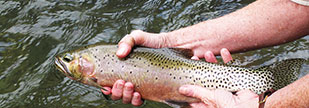Newly Published Fishing and Hunting Book: Recent Works that Have Come Across Our Desk

On this page, we review recent hunting and fishing books. Reviews of all other recent outdoor books are found here.
The following are newly published books that have come across our desk. Note that we are not doing complete reviews here. Rather, we're letting you know that they have been published and are available. At the end of each year, we look over these books and the entries in the National Outdoor Book Awards and put together our "Best Books of the Year" list.
2021 Books that have come across our desk
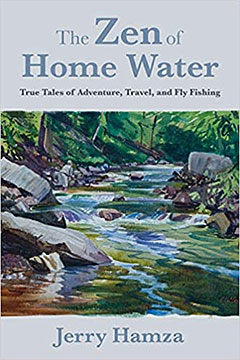 The Zen of Home Water: True Tales of Adventure, Travel and Fly Fishing. By Jerry Hamza, Skyhorse Publishing, NY. ISBN 9781510758898
The Zen of Home Water: True Tales of Adventure, Travel and Fly Fishing. By Jerry Hamza, Skyhorse Publishing, NY. ISBN 9781510758898
The first chapter of this book immediately captured my attention. It is a short piece about a road trip taken by author Jerry Hamza. While on the trip "somewhere between Chicago and Denver," he stops at a log cabin and asks permission from a rural land owner to fish a stream on the man's property. I won't give it away but Hamza catches more than fish that day and you'll come away from it with a smile and the belief that there's still much kindness in this crazy world.
The rest of the book follows with more fishing trips and a few stories thrown in for good measure. What we learn is that Hamza is completely and utterly bewitched by fishing, and he is willing to try it anytime and anywhere.
Ever tried clandestine fishing at a golf course? Hamza has. He even joined a golf club so he could fish a pond beside the fifteenth hole where he had spotted a big lunker. But, alas, even for club members, fishing the pond was verboten. The club president was a surly old curmudgeon and he was clear in his dictum: no fishing. No matter. Hamza's would sneak off while on golf rounds to wet his line. And, of course, one day he got caught red handed on the fifteenth, but not before catching - and releasing - a prized eight pound bass.
Anyone who loves fishing, will enjoy this book, but that first, beautifully rendered chapter has universal appeal and can be savored by all.
(Quick disclosure: "R" rated - no sex, no violence but be prepared for some strong language.)
Amazon.com: More Information or Purchase
2020 - Books that have come across our desk
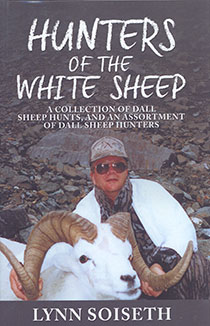 Hunters of the White Sheep. By Lynn Soiseth. Publication Consultants, Anchorage, AK. ISBN 9781594338007
Hunters of the White Sheep. By Lynn Soiseth. Publication Consultants, Anchorage, AK. ISBN 9781594338007
Lynn Soiseth is a long time Alaskan hunter and author. This book includes a selection of his writings on hunting wild sheep. Among the stories of hunting adventures, are several fictional works. Be aware that this is not a how-to book, though one could pick up some hunting hints from the stories. Rather, it's Soiseth's hope that the book is entertaining, and, perhaps, just might kindle a dream or two.
Amazon.com: More Information or Purchase
2016 & 2017 - Books that have come across our desk . . .
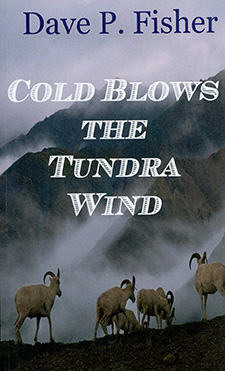 Cold Blows the Tundra Wind by Dave P. Fisher. Double Diamond Books, SeaTac, Washington. ISBN 9781511641845.
Cold Blows the Tundra Wind by Dave P. Fisher. Double Diamond Books, SeaTac, Washington. ISBN 9781511641845.
How to describe Dave Fisher, the author of Cold Blows? One word: prolific.
Fisher has not been sitting around playing tiddlywinks – rather he’s been writing up a whirlwind. A most recent count of his writings includes 29 books and more than 500 works of shorter fiction and non-fiction in national and international publications. He even writes (and recites) a bit of cowboy poetry.
Cold Blows the Tundra Wind is a recent work from his “Northwest Suspense” collection. If you’re a hunter, you’ll eat this one up - cover and all. It takes place in Alaska. Although, interesting enough, I don’t think Fisher even mentions Alaska as the location. He does mention Tok and Tetlin, small towns in east central Alaska, but, as far as I can tell, he never refers to the state itself in the text. Since the work is fictional, I suppose Fisher did that on purpose to add some ambiguity. At the same time, he creates an idyll backwoods setting with wholesome characters who are hardworking, ethical in their hunting practices, and, yes, quick to throw a punch when threatened.
That backcountry idyll, however, is invaded by two poachers. One of the poachers, the kingpin of the two, is smart, crafty and thoroughly crooked. His side kick is a tortured soul who is a sort of comic counterpoint to the boss and ends up taking more abuse from the other characters in the book than Stan Laurel in an old Laurel and Hardy film.
The bad guys also have a wildlife trooper in their pocket. The trooper is shrewd, happy to have his palm frequently greased, and invariably appears on the scene wearing dark aviator glasses. He joins the two poachers in a plot to set-up John Forester, an upright and principled guide, on whose territory much of the poaching takes place.
The plot works to plan, and Forester goes to jail for an illegal wildlife kill. That gets Forester out of the way so the poaching can continue without interference.
Forester’s family, short on cash, is now left without their main breadwinner at the most important time of the year: the beginning of the hunting season. A mysterious guide by the name of Parker shows up and offers to help the Forester family, but he is really helping them? Or is he connected with the bad guys? Or worse?
Cold Blow is not highbrow – and I don’t mean that in a critical way. It’s the kind of book that you can take with you on a plane when you just want something light with enough suspense to keep the pages turning. It has the old standby theme of the good guys versus the bad guys - or more to point, good hunters versus bad hunters – and the drama plays out against the backdrop of the Alaskan backcountry. To sum it up: it’s just plain fun.
Amazon.com: More Information or Purchase
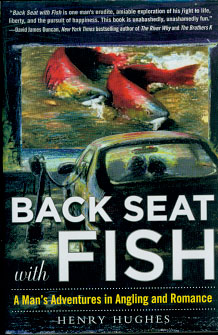
Back Seat with Fish: A Man’s Adventures in Angling and Romance by Henry Hughes. Skyhorse Publishing, New York. ISBN 9781510703636
First off, a warning which, undoubtedly will make the book more appealing—or less—depending upon your perspective. In movie lingo, Back Seat with Fish would be rated “R” (can contain scenes including strong language, violence, nudity, sex and drugs). Indeed, there is some drug use, plenty of drinking, occasional nudity, and a fair amount of sex. Did I say drinking? Yes, lots of that.
And did I say sex? Oh yes. Plentiful sex, but before you get the wrong idea, the book's steamy scenes are portrayed in a tactful and ginger manner. Well, mostly ginger.
The writing? Holy cow. Can Henry Hughes write! Among our “Best of the Year” choices, Back Seat with Fish is among the most literate. It really is about fishing and there's plenty there for fishers to keep the pages turning. More about the book is found in a featured review that we've prepared: Back Seat Fish
Amazon.com: More Information or Purchase
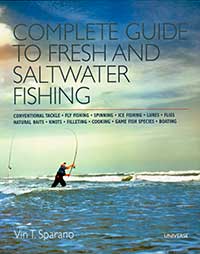 Complete Guide to Fresh and Saltwater Fishing. By Vin T. Sparano
Complete Guide to Fresh and Saltwater Fishing. By Vin T. Sparano
Universe Publishing, New York, NY.
ISBN-13: 978-0-7893-2925-7
.
Reviewed by G. David Parris
(To reach Dave, email him at: Email).
Sparano has delivered on his promise of a “complete guide” with this book. With over 350 pages of detailed information and explanations, intricate diagrams, step-by-step instruction, and a few truly breath-taking photographs, this book could well be used as the textbook for a 16-week college course on fishing.
Section one, “Fishing” is a primer on the practice; subsections are organized from foundations covering the basics like spinning vs. fly fishing all the way through various tackle concerns and ending with “International Gamefish Association Rules and Regulations”. The second and third sections, “Freshwater Game Fish” and “Saltwater Game Fish”, respectively, provide the illustrations, names, descriptions, ranges, habitats, sizes, foods, fishing methods, and recommended baits for each species.
Section four is the fun part for gastronomists, “Cooking Techniques and Recipes”, which also covers field care and long-term storage. Section five, “First Aid for Fishermen”, is one that is usually left out in such books, but one that I find to be an especially helpful and all-too-often overlooked subject for any outdoor endeavor.
Section six is “Boating”, the final chapter, which is just as comprehensive as the previous sections; covering boat types, maintenance, safety, and emergencies. Though perhaps a bit overwhelming for a beginner, this book would be a great complement to any dedicated angler’s library.
Amazon.com: More Information or Purchase
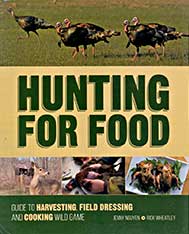 Hunting for Food: Guide to Harvesting, Field Dressing and Cooking Wild Game. By Jenny Nguyen and Rick Wheatley.
Living Ready, Iola, WI.
ISBN-13: 978-1-4403-3842-7
Hunting for Food: Guide to Harvesting, Field Dressing and Cooking Wild Game. By Jenny Nguyen and Rick Wheatley.
Living Ready, Iola, WI.
ISBN-13: 978-1-4403-3842-7
.
Reviewed by G. David Parris
(To reach Dave, email him at: Email).
Hunting animals for food, or “sustenance hunting” (as opposed to subsistence hunting or trophy hunting) is a subject that is gaining more attention in modern hunting circles, and it’s about time. In any modern deer camp, there has always been the hunter who gets some ribbing from the others because they choose their targets based on edibility rather than trophy-scoring status. Shooting “Bambi” instead of the big bucks is even regarded by some as emasculating or somehow wasteful. The emerging contingent, however, is getting more vocal about this flawed and unsportsmanlike logic. More and more, simply harvesting an animal to have a trophy on the wall is falling out of favor, and those of us who choose to hunt for the food we can provide ourselves and our families seem to have more reverence and respect for the animals themselves.
For more on this book, see our featured review: Hunting for Food.
Amazon.com: More Information or Purchase
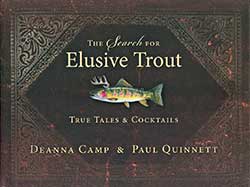 The Search for Elusive Trout: True Tales & Cocktails. By Deanna Camp & Paul Quinnett.
Published by Deanna & David Camp, Elusive Trout – DBA Camp Creative LLC, and Paul Quinnett, QPR Institute, Spokane, WA.
ISBN 978-0-9966530-0
The Search for Elusive Trout: True Tales & Cocktails. By Deanna Camp & Paul Quinnett.
Published by Deanna & David Camp, Elusive Trout – DBA Camp Creative LLC, and Paul Quinnett, QPR Institute, Spokane, WA.
ISBN 978-0-9966530-0
.
Reviewed by G. David Parris
(To reach Dave, email him at: Email).
In the vein of Patrick F. McManus’ outdoor humor writing (and who is credited as an influence in the acknowledgements), this book is laugh-out-loud funny. You don’t have to have a firm grasp on fly fishing, actual fish taxonomy, or a drinking problem to get a kick out of it. Mining such subjects as history, politics, pop culture, and a never ending supply of almost-true fish tales have sufficed to provide plenty of material for this book.
The illustrations are really well done, as are the custom-tied flies recommended to catch such rare beauties as the “Troutalope”, “Deadhead Trout”, “Corporate Trout”, or (my personal favorite) “Punk Trout”. Each fish is accompanied with a cocktail recipe, some of which might even be palatable if not nonfatal.
If someone in your life loves fly-fishing, buy them this book for their birthday, wedding, bar/bat mitzvah, nondenominational holiday, christening, funeral, or any other gift-giving occasion. If they don’t love fly fishing, but enjoy laughing when appropriate (and especially when inappropriate), buy them this book. But read it before you wrap it.
Amazon.com: More Information or Purchase
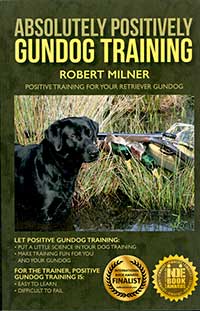 Absolutely Positively Gundog Training. By Robert Milner.
CreateSpace Independent Publishing Platform, North Charleston, SC.
ISBN 9781514221839
Absolutely Positively Gundog Training. By Robert Milner.
CreateSpace Independent Publishing Platform, North Charleston, SC.
ISBN 9781514221839
.
Reviewed by G. David Parris
(To reach Dave, email him at: Email).
Robert Milner’s book on “Positive Training for Your Retriever Gundog” was a finalist in both the International Book Awards and the Next Generation Indie Book awards. For 30 years, he trained dogs using a traditional “compulsion training” model. During the latter part of this period, he began to question this model while observing training in the United Kingdom. Thus, in 2002, he switched to a “positive training” model and cites results of training dogs 300% faster.
Using science-based techniques that are just starting to emerge; he outlines the model well for anyone interested in training a gundog using a method that focuses on reward instead of punishment. The science behind it largely comes from several myths about dog behavior, linking them more to wolves than they should be. Dogs have evolved to survive with humans, and as such are much more tuned in to human behavior than they’re usually given credit for. Relying on fact-based information instead of myth and tradition, and clearly outlining his logic for doing so, it is easy to see how these new training techniques could pay off for the trainer who is looking for a gundog that would also be a good family pet to have around the house.
Amazon.com: More Information or Purchase
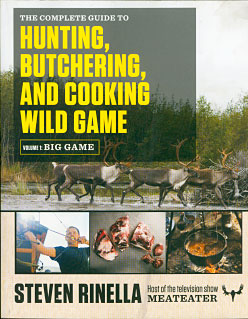 The Complete Guide to Hunting, Butchering, and Cooking Wild Game (Volume 1: Big Game) By Steven Rinella.
Spiegel & Grau, New York, NY.
The Complete Guide to Hunting, Butchering, and Cooking Wild Game (Volume 1: Big Game) By Steven Rinella.
Spiegel & Grau, New York, NY.
ISBN 978-0-8129-9406-3
.
Reviewed by G. David Parris
(To reach Dave, email him at: Email)
.Steven Rinella is probably best known for his television show, “Meateater”, and perhaps another television series, “The Wild Within”. His television work is certainly remarkable in the huge swath of hunting, fishing, and general outdoor programming available today. Many who have seen his work say, over and over, “He’s the real deal.”
We have much more about this book in a featured review: Hunting, Butchering
Amazon.com: More Information or Purchase
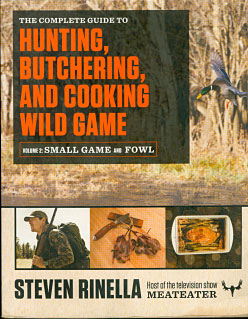 The Complete Guide to Hunting, Butchering, and Cooking Wild Game (Volume 2: Small Game and Fowl). By Steven Rinella.
Spiegel & Grau, New York, NY. ISBN 978-0-8129-8705-8
The Complete Guide to Hunting, Butchering, and Cooking Wild Game (Volume 2: Small Game and Fowl). By Steven Rinella.
Spiegel & Grau, New York, NY. ISBN 978-0-8129-8705-8
.
Reviewed by G. David Parris
(To reach Dave, email him at: Email)
This second volume from Steven Rinella is equally as valuable as the first. Besides being a must-have companion piece for the first volume, it examines too many aspects of small game hunting than I can describe here. From weapons and gear to methods and techniques, it’s every bit as informative as the first volume is. Using the same template as the first, this second volume is well-organized and full of clear illustrations and photographs.
The first section is “Gear” which is pretty self-explanatory, but full of great tidbits. Then “The Basics”, which covers the general aspects of small game hunting like location, techniques, and tips for success. Third is “Species”, which is basically divided between small mammals and birds. The penultimate section is the shortest, “Butchering”, because this is a very simple process with small game, but Rinella’s provided the sorts of tips that even a long-time hunter can benefit from. Lastly, as in the first volume, is the section detailing why most of us hunt in the first place, “Recipes”. This fifth book from Steven Rinella is consistent with his well-written and passionate style, and I’d recommend it to anyone looking to up their game or just be more informed while getting some entertainment in.
Amazon.com: More Information or Purchase
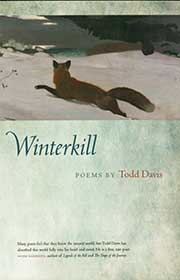 Winterkill. By Todd Davis.
Michigan State University Press, East Lansing, MI. ISBN 978-1-61186-196-9
Winterkill. By Todd Davis.
Michigan State University Press, East Lansing, MI. ISBN 978-1-61186-196-9
.
Reviewed by G. David Parris
(To reach Dave, email him at: Email).
This poetry collection is rife with the life and death found in nature, and interwoven with how humanity is tied to nature even as we strike back at it. Todd Davis clearly knows his material, and doesn’t shy away from any of the grim aspects of living. Some of the poems are a tribute to the natural world, while others relate the speaker’s place in the destruction he documents. He relates tales of hunting and fishing with both reverence and regret, without preaching that either are to be cherished or chastised. One needs not have studied poetry, or know about line breaks and enjambments, or pick up slant rhymes to enjoy these works. Writing poetry about hunting, in particular, can be difficult to steer clear of bravado or maudlin, but Davis has done remarkably well with it. I would recommend this book to anyone who like poetry, likes the outdoors, or better yet, both!
.
Amazon.com: More Information or Purchase
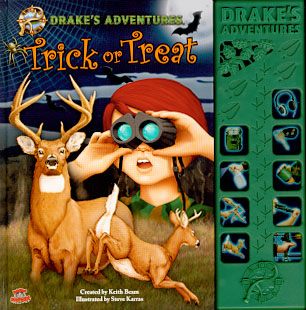
Drake's Adventures: Trick or Treat. Created by Keith Beam Illustrated by Steve Carras. Mad Badger Productions, Waunakee, WI. ISBN 978-0-9862155-1-3
Reviewed by G. David Parris
(To reach Dave, email him at: Email)
The second installment of the "Drake's Adventures" children's books is "Trick or Treat". This time, Drake is going on a whitetail deer hunt with his father. As is standard for the series, the right-hand side of the book provides buttons for sound effects and/or narration, along with a headphone jack for quiet, private enjoyment.
The story starts by introducing "Spider", the buck that Drake and his father have selected to hunt. The pair prepares and goes on the hunt, opting not to harvest a smaller deer that approaches their decoy setup in response to their calls. Common practices like antler rattling and use of scent control are also woven into the narrative. In the end, Drake's dad harvests "Spider". The upcoming third installment of the series promises to introduce Drake's little sister Cricket and duck hunting in "Cattail Point".
Amazon.com: More Information or Purchase
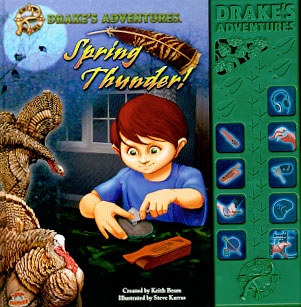 Drake's Adventures: Spring Thunder! Created by Keith Beam Illustrated by Steve Carras. Mad Badger Productions, Waunakee, WI. ISBN 978-0-9862155-0-6
Drake's Adventures: Spring Thunder! Created by Keith Beam Illustrated by Steve Carras. Mad Badger Productions, Waunakee, WI. ISBN 978-0-9862155-0-6
Reviewed by G. David Parris
(To reach Dave, email him at: Email)
This children's book series, "Drake's Adventures", aims to engage children in the outdoors via hunting and shooting sports with accounts of a young boy named Drake tagging along on hunting trips with his father.
The format of a traditional printed book is combined with buttons along the right hand side that provide sound effects. The buttons are labeled with pictures that conform to prompts within the text. There is also a button with a picture of headphones, which provides narration of the entire story when pressed, allowing children to follow along if they are still learning to read.
This may well be the case, as the creator's state they are trying to instill an interest in the traditions of hunting by the age of five. Parents will also appreciate the headphone jack, which allows the listener to enjoy the sound effects privately as much as they want.
The first installment of this series, "Spring Thunder!", tells the story of Drake and his father going on a turkey hunt. Drake practices his turkey calls the night before, and helps with the setup of the blind and decoys early the next morning. He then helps his father call in a large tom to harvest. As the pair departs triumphant, Drake's father explains the traditions of hunting.
Though designed for a somewhat limited market, the book is effective in engaging young children in aspects and motivations of hunters that they would probably not be exposed to otherwise in most children's media.
It's hard to conceive of the book being a standalone, however, and would most likely be combined with a set of values that children already see their parents modeling. In this way, those values are positively reinforced in conjunction with parents' tutelage. Some detractors may try to assert that this is some form of brainwashing, but it really follows a long tradition in children's literature. Values, beliefs, morals, and other traits that parents want to instill in their children have long been transmitted through stories in cultures worldwide.
Amazon.com: More Information or Purchase
2015 - Books that have come across our desk . . .
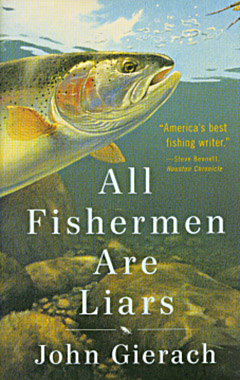
All Fishermen Are Liars By John Gierach. Simon & Schuster, NY. ISBN 9781451618310
John Gierach is surely in the top echelon of outdoor writers, but there is nothing rarefied about his writing. He emerges from his books and articles as an easy going, down-to-earth guy, not much into fancy clothes, who simply loves to fish.
It comes, then, as no surprise that his writing style isn't fancy either. He doesn't write at his readers. He writes with his readers.
But there's something else, a quality evident just below the surface, that makes Gierach such a pleasure to read, and that's his warmth. Reading his books is like sitting down with a favorite uncle and listening to his stories while a fire crackles and pops in a nearby wood stove. What could be better?
All Fisherman are Liars consists 22 stories, ranging far and wide from way up north in Canada to Michigan's Upper Peninsula to his home fishing streams in Colorado. In all of these, his simple but highly effective story telling skills are on full display.
Thoreau who once wrote that "many men go fishing all of their lives without knowing that it is not fish they are after." There's no better proof of that truism in the writings of John Gierach.
Amazon.com: More Information or Purchase
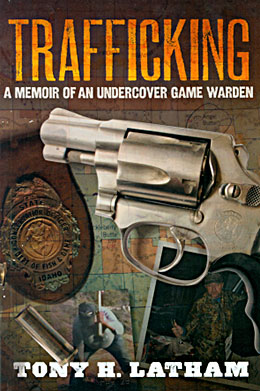
Trafficking: A Memoir of an Undercover Game Warden. By Tony Latham. ISBN 9781475209891
This is a gripping and absorbing true story, skillfully and precisely told. If there is any one book that tells what it’s really like to be on the front lines, protecting our nation’s wildlife, this is the one.
Trafficking will quickly pull you in and keep you turning the pages. I promise. You won’t be able to put it down. It’s that good.
For a more lengthy review: Trafficking
(Amazon.com: More Information or Purchase)
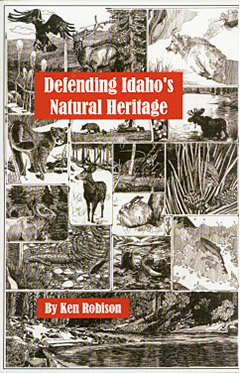
Defending Idaho's Natural Heritage By Ken Robison. Boise, ID. ISBN 9870578140933
Defending Idaho's Natural Heritage is an impressive and penetrating history of Idaho's conservation movement, and there was no better person to write that history than Ken Robison.
Ken Robison is a journalist and for many years served as the editorial editor at Idaho's flagship newspaper, the Idaho Statesman. He was later elected to the Idaho legislature, but he continued reporting and writing on environmental issues, founding a magazine called the Idaho Citizen.
He was present on the scene, a keen-eyed observer and reporter, during the most tumultuous — and productive — times in the Idaho conservation movement.
It was during the three decades of the 1960's, 70's and 80's that monumental battles were waged over Idaho's wild lands and rivers. These were David and Goliath battles: small Idaho-based conservation groups and individuals with little or no funds up against business lobbyists and corporate lawyers with unlimited expense accounts. What came from those struggles are such national treasures as the River of No Return Wilderness, the Sawtooth Recreation Area, the Selway-Bitterrroot Wilderness, and Hell's Canyon National Recreation Area.
Robison's book is one of the most important works on the Idaho conservation movement ever to be published, and it will long be a reliable source of historical information.
For a more lengthy review, see Defending Idaho's Natural Heritage
Defending Idaho can be purchased directly with the author's site: Defending Idaho
2014 - Books that have come across our desk . . .
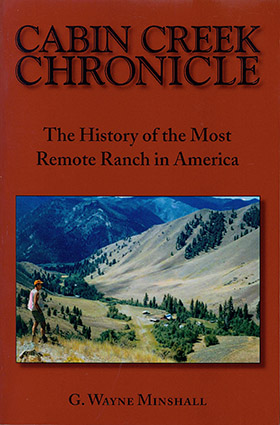 Cabin Creek Chronicle: The History of the Most Remote Ranch in America By G. Wayne Minshall, Streamside Scribe Press. ISBN 9780984949014
Cabin Creek Chronicle: The History of the Most Remote Ranch in America By G. Wayne Minshall, Streamside Scribe Press. ISBN 9780984949014
The central Idaho wilderness has left an indelible mark on author Wayne Minshall. It was plainly evident in his first historical work, a fascinating account of the Caswell brothers who through plain hard work and inventiveness eked out a living along Big Creek, a major stream in what is now known as the Frank Church River of No Return Wilderness.
Minshall returns to the Big Creek country in his second book Cabin Creek Chronicles, and once again, recounts the drama of human life far away from civilization.
Even in this remote country where only a handful of people live, there are murders, adultery, and greed intermixed with a modicum neighborly goodness. His book is all focused on one piece of ground — and the succession of changes that occurred there — at the mouth of Cabin Creek, first homesteaded by the Caswells.
Cabin Creek Chronicle is another exceptional work by a fine historical writer. Put this one on your “must read” list. You won’t be disappointed.
For a more lengthy review, see Cabin Creek Chronicle
Amazon.com: More Information or Purchase
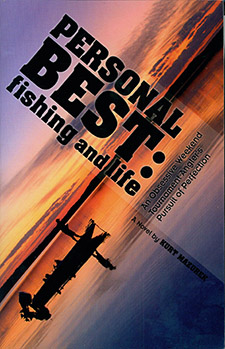 Personal Best - Fishing and Life: An Obsessive Weekend Tournament Angler’s Pursuit of Perfection. By Kurt Mazurek JLS Mazurek Publishing ISBN 9781940474021
Personal Best - Fishing and Life: An Obsessive Weekend Tournament Angler’s Pursuit of Perfection. By Kurt Mazurek JLS Mazurek Publishing ISBN 9781940474021
This is a warm-hearted novel about weekend fishing tournaments. What are fishing tournaments? They are contests in which fishermen attempt to catch as many fish as they can of a certain species.
The fish are kept in live tanks in the competitors’ boats until, at the end of a certain amount of time, officials weigh the fish and return them to the water. The fisherman with the heaviest catch is declared the winner.
If you’re looking for seamy scenes, or guns blaring and fists flying, you won’t find it here. There are, however, some very competitive characters in the novel, and one in particular who will stop at nothing to win.
If you’re a fisherman — and particularly if you’re keen on competitive fishing — you’ll find Mazurek’s novel an entertaining read. Take it with you fishing. Keep it handy for that day when you need a little encouragement, sitting alone in the boat, trying everything, and no matter what, the fish just aren’t biting. Who knows? After reading it, your luck may change.
Amazon.com: More Information or Purchase
2013 - Books that have come across our desk . . .
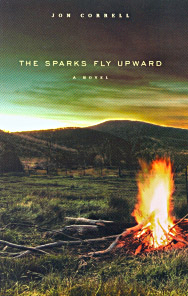 The Sparks Fly Upward: A Novel. By Jon Correll, Inkwater Press, Portland, OR. ISBN 9781592998883
The Sparks Fly Upward: A Novel. By Jon Correll, Inkwater Press, Portland, OR. ISBN 9781592998883
Best of 2013
Sparks Fly Upward takes place in the Blue Ridge Mountains of North Carolina in the early 1970's. It’s about Nate Miller as he finishes high school, leaves his rural home, and goes on to college in the big city. It’s about young romance and homespun decency - and one inevitable, fatal flaw, the consequences of which are foreshadowed on a hunting trip taken by Miller in which he drives himself to near collapse tracking a deer that he has wounded.
What impressed me most about this book is the author's ability to capture dialog. There's nothing contrived about the characters. They are well developed, and real enough that you feel like you're in the midst of the hill country, standing with Nate Miller as he interacts with family and friends. I found it a fine first effort by a new author and quite worthy of having a look.
Amazon.com: More Information or Purchase
2011 - Books that have come across our desk . . .
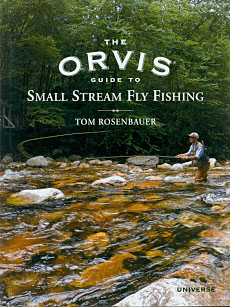 The Orvis Guide to Small Stream Fly Fishing. By Tom Rosenbauer. Universe, New York. ISBN 9780789322258
The Orvis Guide to Small Stream Fly Fishing. By Tom Rosenbauer. Universe, New York. ISBN 9780789322258
With the publication of this large format, scrumptiously illustrated work, Tom Rosenbauer has added another splendid book to his burgeoning list of titles on fly fishing. His previous Guide to Fly Fishing has been exceptionally successful among the fishing kindred, and the Orvis Fly-Tying Guide authored by Rosenbauer was a 2001 National Outdoor Book winner.
In this book, Rosenbauer concentrates on small streams - that is streams less than 30 feet across. Or to put it another way, streams where a single cast can, without much effort, end up snagged in the brush on the other side.
Why small streams? James Babb the editor of Gray's Sporting Journal who wrote the introduction to Rosenbauer's book, posits that these are the streams where one can truly learn about fly fishing. Most importantly, these are the streams on which one can really get away from the crowds and still find solitude. Babb explains it this way:
"Fly fishers these days seem mostly inspired by magazine covers featuring buff dudes wearing flashy clothes and brandishing big fish caught from name-brand waters, where their long, carefully schooled casts unfurl like candy canes. But on a small stream, there's no room for that beautiful school room cast. And your reward, if you make the cast and don't fall splat into the pool? A wild trout the length of a dollar bill, most likely. Try that for a magazine cover."
If you want to get away from streams found on magazine covers - and experience the essence of fly fishing - Rosenbauer's book is a fine and pleasant way to get underway.
Amazon.com: More Information or Purchase
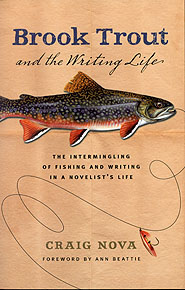 Brook Trout and the Writing Life: The Intermingling of Fishing and Writing in a Novelist's Life. By Craig Nova. Eno Publishers, Hillsborough, NC.. ISBN 9780982077146.
Brook Trout and the Writing Life: The Intermingling of Fishing and Writing in a Novelist's Life. By Craig Nova. Eno Publishers, Hillsborough, NC.. ISBN 9780982077146.
Craig Nova is a novelist of note, having written twelve fictional works and one autobiography. This book is a little bit about trout fishing and a lot about his writing life and family. Throughout the book, these three subjects intersect at times, diverge and intersect once again. Nova has a nice way with words: they tumble out over the page, soothingly and revealingly, like water flowing over a stony river bed.
Amazon.com: More Information or Purchase
[End of Listing]

